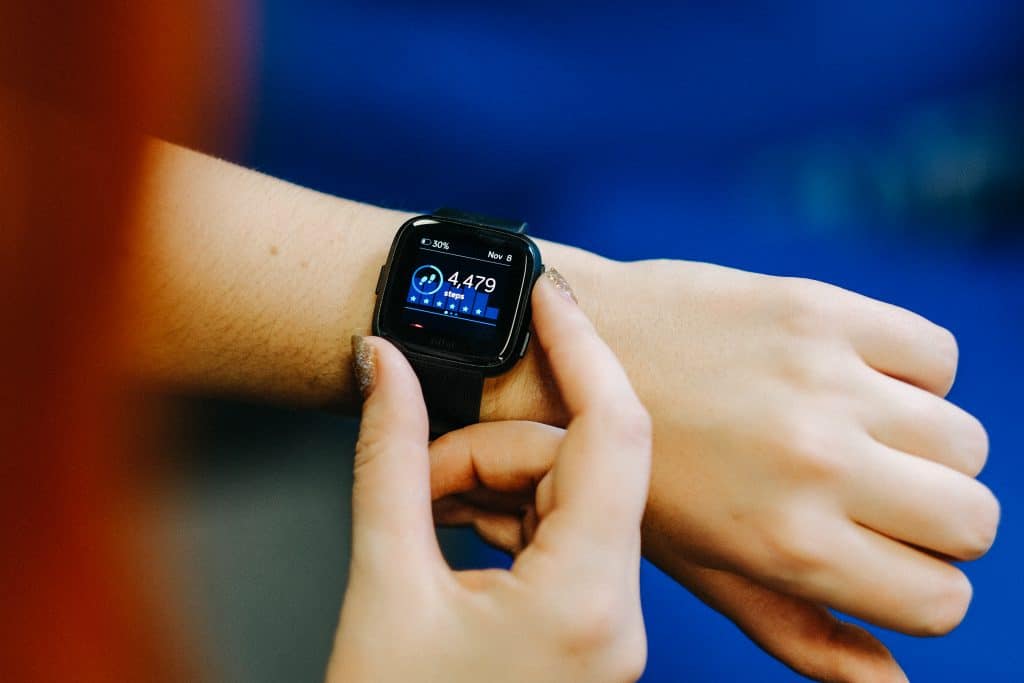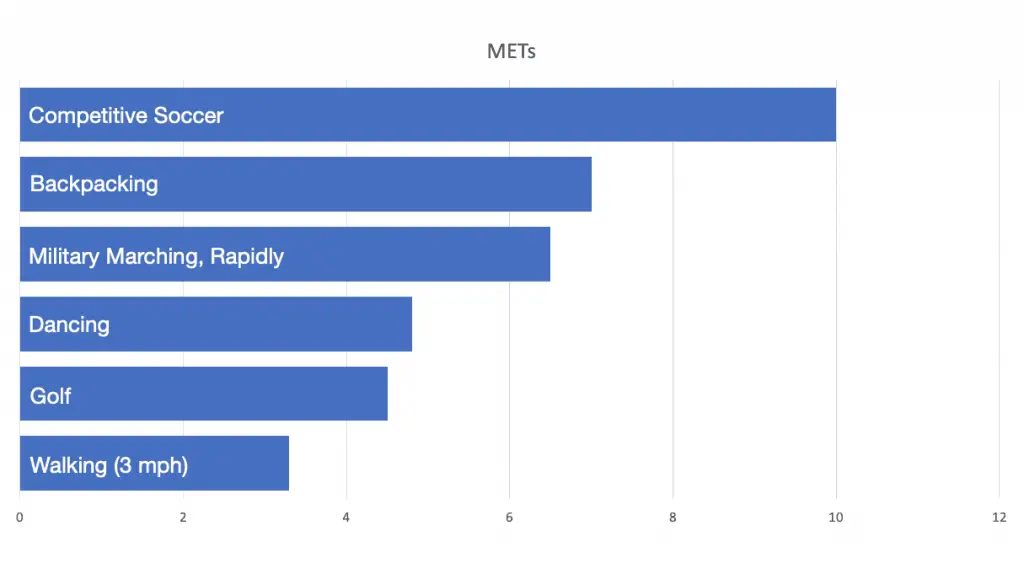
Use our Rucking Calorie Calculator to find out how many calories you burned in a ruck. You should also calculate your BMR to know exactly how many calories you need to eat in to reach your fitness goal with rucking.
When selecting your MET Activity, choose the type of ruck you engaged in. The calculator uses the closest estimates based on the Metabolic Equivalent of Task to determine how many calories you burned. This calculator also allows you to calculate calories burned when ruck marching.
Note: If you added weight to your rucksack, do not add that to your own weight when using the calculator. The MET activity field takes that into account.
When calculating how many calories you burn from a ruck, there are a few things you need to consider:
- If your goal is to lose fat from rucking, you must be in a caloric deficit. – Combine the number of calories you burn on a daily basis with the result of the rucking calorie calculator to see if you are burning enough calories from your ruck to lose weight.
- Everyone’s Basic Metabolic Rate (BMR) is different.
- Metabolic Equivalent Table (MET)
Find out how rucking helps you lose weight and lose fat & check out my full body transformation through rucking.
How To Calculate Total number of Calories you Burned?

The number you got from the Rucking Calorie Calculator is based off slight modifications made to the metabolic Equivalent of Task (MET) calculation to accommodate rucking.
To fully understand how many calories you need to burn from rucking, you also need to consider your body’s Basic Metabolic Rate. Everyone burns calories at different rates. Some people burn calories faster than others and vice versa.
By combining the inputs from the BMR and Rucking Calorie Calculator you can find out how many calories your body needs to burn in order to gain, maintain, or lose weight from rucking. You can also find out if you’re not burning enough calories based on your body’s metabolic rate.
Follow the steps below for a comprehensive understanding of how many calories you need to burn from rucking:
- Fill in the fields in the Rucking Calorie Calculator.
- Fill in the fields in the Basic Metabolic Rate (BMR) Calculator.
- Add both numbers (Rucking Calculator result + BMR Calculator result).
- Subtract your caloric Intake of the day.
Real Example of How Many Calories Are Burned From Rucking
With the rise in popularity in rucking as a sport, more and more people are choosing to ruck as a means of burning calories and to get in shape. I’ve included an example below to demonstrate how you can go about calculating calories burned while rucking.
Example – Sarah
| MET Activity (Input For Rucking Calculator) | Rucking On Flat Surface (Carrying 20 – 40lbs) |
| Rucking Time (Input For Rucking Calculator) | 1 Hour |
| Height (Input For Rucking Calculator) | 5 Foot 8 Inches |
| Sex (Input for BMR Calculator) | Woman |
| Age (Input for BMR Calculator) | 27 |
| Weight (Input for BMR Calculator) | 150 lbs |
| Activity Level (Input for BMR Calculator) | Moderate Active |
Sarah’s Results
| Calories Burned from Rucking (Results from Rucking Calorie Calculator) | 580 |
| BMR Calculator (Results from BMR Calculator) | 2,269 |
| Total Calories Burned (BMR + From her ruck) | 2,849 |
According to the Rucking Calorie Calculator, Sarah burned 580 calories. Moreover, according to the BMR calculator, Sarah is moderately active and given her weight and height, she needs 2,269 calories to maintain her weight.
How many calories does Sarah need to eat to lose weight from rucking?
Sarah burned 580 calories from her ruck. She also needs 2,268 to maintain her weight (given her moderately active lifestyle). Therefore, Sarah’s caloric intake needs to be (100 – 500 calories) less than 2,849 cals (580 + 2,268) to lose weight.
How many calories does Sarah need to eat to maintain her weight?
Sarah would have to eat exactly 2,268 calories to maintain her weight.
How many calories does Sarah need to eat to gain weight?
Sarah would have to eat more than 2,268 calories to gain weight.
Speaking of Sarah’s rucking session, check out my guide covering everything about rucking for women.
What is Basic Metabolic Rate & How to Calculate Your BMR
According to Verywellfit, your BMR is the number of calories you need to perform everyday basic life functions such as breathing, cell production, protein synthesis, and other functions that your body naturally works on. Calories equates to energy, and your body needs energy to perform these functions to help you grow and just simply survive.
When using the BMR calculator below, use that number as an estimate. Whether you’re wearing the latest fitness apple watch, Fitbit, or any other fitness tracker, no contraption out there can 100% accurately calculate your BMR (calories you need to consume to lose, maintain, or gain weight).
The fitness trackers use algorithms and their own calculations. These calculators are meant to give you an estimate of how many calories you burned.
However, with that said, the BMR calculator is a great tool to give you an estimate of where you stand in terms of caloric intake.
If you exercise regularly though, you will naturally have a higher BMR. This is because your body will have to work harder to repair itself. Another thing to consider is that men and women have different BMR’s. This is because men naturally tend to have more muscle mass than women, and therefore men typically have higher BMR values than women. As we age, our BMR goes down as we tend to have less muscle mass.
What is Metabolic Equivalent of Task (MET)?
MET is the estimated amount of energy expenditure for common physical activities. According to healthline, metabolic rate is the rate of energy expended per unit of time. It’s a way to describe the intensity of a workout. One MET is the energy required for simply sitting while rested – This is also considered to be your Basic Metabolic Rate. The energy/calories you need to simply perform basic-life functions.
According to the Metabolic Equivalent Table, regular activities such as playing with the dog (moderately) or even gardening is equivalent to 4.0 METs. Here’s a breakdown.
Check out our top tips for rucking your dog!

Does Rucking Burn Calories? Does Rucking help you reach your fitness goal?
Yes, absolutely it does, as long as you monitor your diet and ensure your caloric intake is on a deficit in respect to your Basic Metabolic Rate (BMR). This is because rucking is a form of Low Intense Steady State training (LISS). LISS style workouts are when you elevate your heart rate to around 60% of your maximum heart rate and keep it at that rate for a set period of time.
A study conducted by the Journal of Sports Science and Medicine found its participants enjoyed LISS style training compared to High Intensity Internal Training (HIIT). This make sense because it requires less mental effort and as a result, you probably have a higher chance of sticking to 1 hour of walking with a weighted rucksack compared to 20 minutes of high intensity – Terry Crews – style workout. If you’d like to ruck and don’t have a rucksack, you can always consider using a weighted vest for rucking.
Check out our list of rucking events to find one near you. If you’re looking for the toughest rucking challenge, check out our guide on the Norwegian ruck march where you will surely burn a lot of calories.
Disclaimer: The information which you calculate from the rucking calorie calculator is intended for use by you as a guide only, It is not 100% accurate to you as every body is different, and everyone rucks differently.
Rucking vs Walking: Which Burns More Calories
Simply put, rucking burns more calories than walking. This is because the added weight in the rucksack adds more resistance, which requires your body to use more energy (calories).
For example, if a 180 lbs person were to walk for 1 hour on a flat surface, they’d burn around 246 calories. If that same person with the same weight were to have rucked during that hour carrying 21lbs – 42lbs, they’d burn around 696 calories.
Reminder, everyone burns calories at different rate depending on many factors such as weight, metabolism, genetics and other factors. The above numbers are estimated averages.
Rucking vs Running: Which Burns More Calories
Running Burns more calories than rucking. However, since rucking is considered to be a resistance type of workout, it is expected. It’s worth noting that resistance training typically burns less calories than high intensity workouts like running. However, if your goal is body recomposition (Losing fat while maintaining or gaining muscle) then burning more calories through running may not be the best course of action.
Rucking has a strength gaining component to it that can not be found in running. Learn more about how rucking helps you gain more strength.

